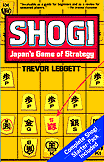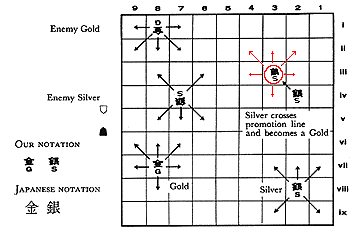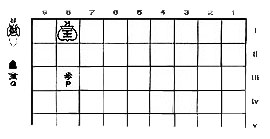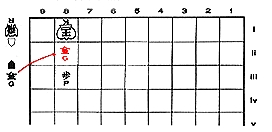
SHOGI Japan's Game of Strategy
Extract
The Paratroops
Now that you have an idea of how the pieces work, it is time to introduce
you to a revolutionary feature of Shogi, found in no other form of chess.
This is the "drop" - a sort of paratroop attack.
When you capture an enemy, it is not dead.
It becomes yours and you keep it by the side of the board.
Any time, instead of a move, you can drop one of these captured men on any
vacant square. The piece points towards the enemy, and it is your piece
and works for you.

The King moves like a chess king: the rook, bishop, knight have basically
similiar moves to the corresponding chess pieces; the Lance is a Rook that
can move only straight forward down a file.


The pieces are here shown with the Japanese character on top, and a Western-style
icon (such as a crown for the King, and a castle for the Rook), and a big
initial letter (K or R) below that. In this way players will gradually become
accustomed to the Japanese characters, but having always the key on the
piece. Two specifically Shogi pieces are the Gold and Silver Generals: they
are like a weaker King.
Synopsis
Shogi is the only completely up-to-date form of chess. The original Indian
game was fought out by Kings, their ministers, horsemen, and elephants,
on the ground. It was all at close quarters, so to speak. This is still
the game in the West. The Chinese introduced cannon, which fire long-range
shells over the heads of intervening pieces. But it was the Japanese in
the 16th century who anticipated air power and paratroops: in lieu of a
move on the ground of the board, a player can drop a piece from his 'store'
anywhere on the board.
The store consists of former enemy pieces, which he has captured, and which
now become mercenaries and fight for their capturer.
In Western chess, where a captured piece is killed, the number of active
pieces becomes fewer and fewer. In Japanese chess, on the other hand, all
the pieces are active throughout the game; they are either on the board,
or in the 'stores', waiting to be dropped.
The strategy is modern: a Home Guard round the King, to deal with paratroops,
and an expeditionary force, supported by paratroops, attacking the other
King and his Home Guard. So in a typical game, both sides are simultaneously
attacking and defending. The end-game is intensely exciting, and in practice
there are no draws.
The book gives step-by-step instruction with easy-to-follow diagrams. The
board, pieces, paratroops, and basic attacks and defences are fully explained,
as also the main openings and endgame strategies. The Chinese characters
of the Japanese game are simplified and identified with their chess equivalents:
King, Knight, Rook, Bishop, Pawn. The extra ones are also clearly marked:
G for Gold General (Kin-sho), S for Silver General (Gin-sho) and so on.
Trevor Leggett holds the high degree of Fifth Dan in Shogi, the brush-strokes
of his diploma being those of the legendary Past Master Yasuharu Oyama.
This is a rare honour; Master Oyama has also written an introduction recommending
the book.
Contents
Historical Introduction
The Board and the Men
Learning to use the pieces
The PARATROOPS
The Value of the Pieces
Novices' Game
Introduction to the Openings
The Static Rook openings
The Yagura
The Ranging Rook openings
A few Game Positions
Appendix: How to read a Japanese score
Recommendation of the book by Past Master Yasuharu OYAMA, many times all-Japan
champion, who on behalf of the all-Japan Shogi Association conferred on
Trevor Leggett the grade of Fifth Dan, brushing the diploma with his own
hand, a rare honour.
Reviews
The step-by-step instructions and thorough diagrams make this book invaluable
both as a guide for beginners and a review for seasoned players ...
The Oriental Economist
The explanations are easy to understand and easy to follow ... Recommended...
Library Journal
The book is as well got up as we expect all publications of the House of
Tuttle to be, and the thorough diagrams carry step-by-step instructions
...
South China Morning Post
Leggett writes succinctly and well; his love and fascination for the game
become apparent on every page.
Shipping &Trade News (Tokyo) ...
the author Trevor Leggett is one of the few highly qualified and recognized
authorities and the first foreigner to compile a book on the ancient Japanese
version of the chess game.
California Daily News
|

